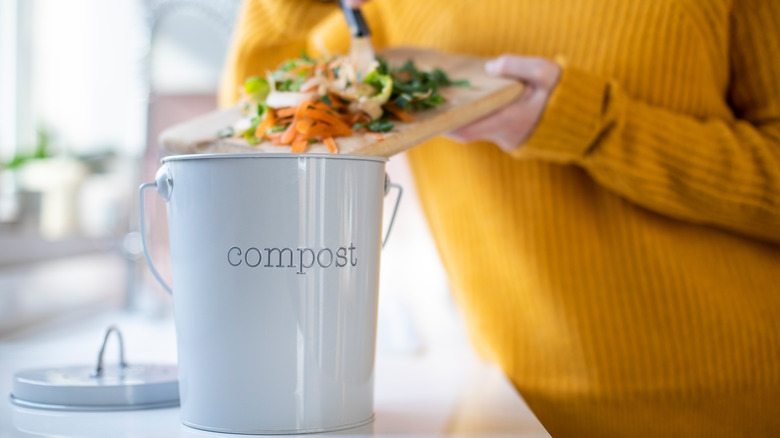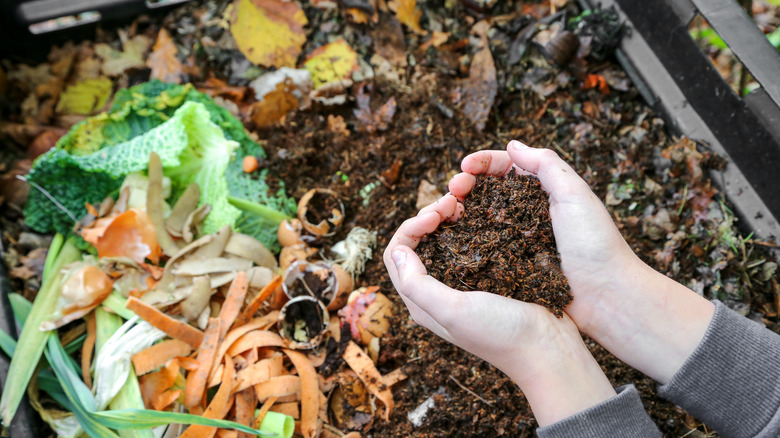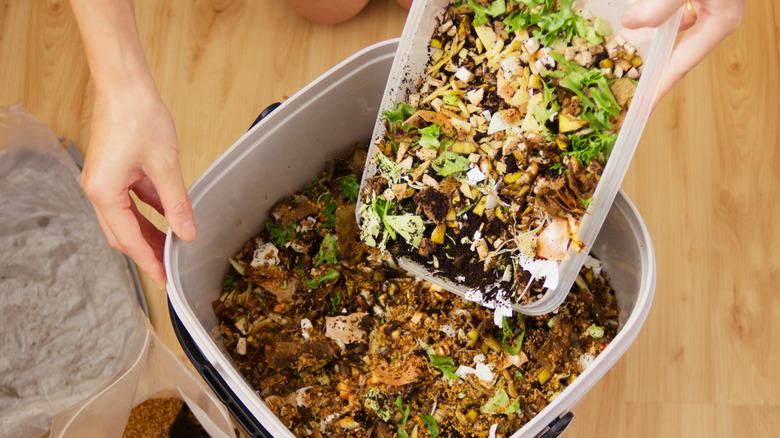How To Start Composting Even If You Live In A Small Apartment
As sustainability efforts rise, many people are starting to take matters into their own hands with ways they can help from their own homes. Many people are opting to live a more sustainable lifestyle by optimizing water usage and energy as well as other conservational efforts, per Constellation. This can look like buying products made of recycled materials or replacing fluorescent light bulbs with L.E.D. ones. Maybe you've switched to natural cleaning products or taken a big step in installing solar panels. Whatever it may be, the path to sustainability doesn't always have to be too difficult.
When it comes to waste, it can be overwhelming to think about the kind of impact trash has on the planet. According to EPA, the amount of waste can be narrowed down to 4.9 pounds per person per day, totaling up to 292.4 million tons of municipal solid waste (M.S.W.), as reported in 2018. Of that waste, nearly 94 million tons of M.S.W. were recycled or composted, equaling a 32.1% recycling and composting rate. Although people are recycling or composting at lower rates, these methods still prove to be effective and sustainable for the health of the planet. If you want to pursue this sustainable effort, it's fairly simple to compost at home, even in an apartment.
The basics of composting
Composting is not only a great way to be more sustainable, but it's also a convenient way to get rid of some of your food trash. Composting is the process of "decaying" or breaking down organic matter, such as food waste or plant materials, to create a nutrient-rich mixture to help encourage and maintain proper soil health for the earth (via Bungalow). Under the ideal conditions through composting, food waste breaks down quicker and more effectively. In a landfill, food or plant material waste is often deprived of oxygen as it gets buried between plastic trash bags, paper, glass, and more. Because of this, decomposition occurs slowly, resulting in an overproduction of methane, a greenhouse gas that highly contributes to climate change, per Vice.
According to Eartheasy, compost is a healthy combination of carbon and nitrogen material. Carbon-rich material consists of items like dried leaves, stems, coffee grounds, egg shells, peat moss, wood, bark dust, and other similar materials. This helps keep the compost light. Nitrogen-rich materials are protein-rich matter like food scraps, lawn clippings, green leaves, kitchen waste, and other similar materials to produce enzymes in the compost. Eartheasy recommends a balance of one-third green materials (nitrogen) and two-thirds brown materials (carbon) so that the nitrogen-rich scraps don't become overpowering and smelly. Avoid composting meat, fish, bones, dairy, or diseased plants to prevent odors, pests, or insects in order to maintain the health of your compost.
How to get started
Fortunately, anyone can compost in one way or another. This is especially beneficial if you have your own garden or houseplants to use the soil for. Even if you don't have either, composting is a great way to throw away your food scraps in a way that still helps protect the planet. You can always donate your compost to the local farmers market, community garden, or city pick-up if offered in your city, per Bungalow. To get started with apartment composting, all you will need is a small plastic bin, shredded newspaper, soil, and a drill. The key is to keep it small yet effective, so you can properly fit it anywhere in your apartment.
Start by drilling holes on one of your plastic bins along the top edge of each side, keeping each hole about one to three inches apart. Then proceed to drill holes on the bottom of the bin evenly spread out. These holes will allow for airflow, one of the most important aspects of composting, and for draining any liquid resulting from the compost. After you have finished drilling your holes, place your punctured bin inside another bin or on top of a tray without holes, so nothing leaks out into your home space. Next, add soil followed by dry absorbent material like newspaper or sawdust on top of it. Every time you place any organic material inside your bin, make sure to layer the absorbent material around it to prevent mold or foul odors. Additionally, keep a tight-sealed lid over it to prevent unwanted pests (via The Spruce). In about three months, your compost soil should be ready to use.


